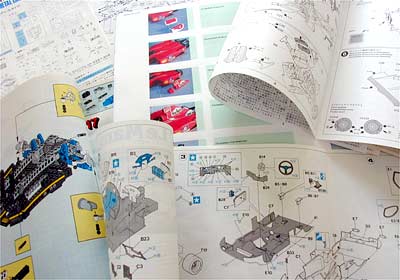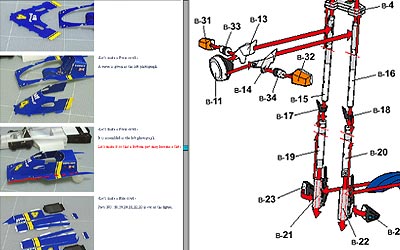|
|
|
| Prototyp : Model : Jaguar XJR-10 / 11 |
|
Process, Part Seven.
Introduction - 1 2 |
|
All model kits have some form of instructions. These graphics typically are serial progressions or exploded views showing the treatment and arrangement of parts as well ordering their assembly. Details for part numbers, painting information, sub-assemblies and assembly sequence provide further information. The instructions have to rely on images more than words to avoid confusion as builders of different nationalities all reference the same documents. Shown here are illustrated plastic kit examples from Tamiya and Hasegawa, photographic paper model instructions from Y. Tanaka (printed from his site), and a manual for a Lego Technic model.
|
 |
|
Perhaps the most beautiful treatment I have seen is from Tameo's computer 3-d renderings. Rendered in color using 3-d models no doubt from their CAD design process, the graphics are fully dimensional and perhaps the clearest presentation of parts relationships. Y. Tanka's photo sequences are similar in some principals, however the exploded view is something that cannot be done without much complex arranging for the camera. The 3-d rendering allows for careful control of what is presented, allowing the illustration to focus the builder more effectively. Does anyone know what CAD program Tameo is using? Tell me, please.
|
 |
|
The paper model has to have details built up from many individual elements which would normally represented in plastic kits as a few complex moulded parts. Although there is no painting to specify, the number of the paper model's parts require its instructions to be more complex than most plastic kits. So what is the best presentation? A simple sequence of steps? The drawn exploded view shows a better relationship of peices, but the building order is far less clear. Perhaps a combination of sequence and exploded view? An additional challenge is creating a format suitable to the builder's environment. Should instructions be computer-based? A printed sheet? Or an online sequence, which can be printed? How does the computer fit into the builder's environment and building technique? Yamaha uses downloadable instruction 'booklets' which have several pages of illustrations showing each stage of the build while Y. Tanaka breaks down his F1 models into several pages of sequenced photos, sometimes with a bit of graphical information added to them, and presents the pages on his site.
|
 |
| Un-building, step by step... > > |